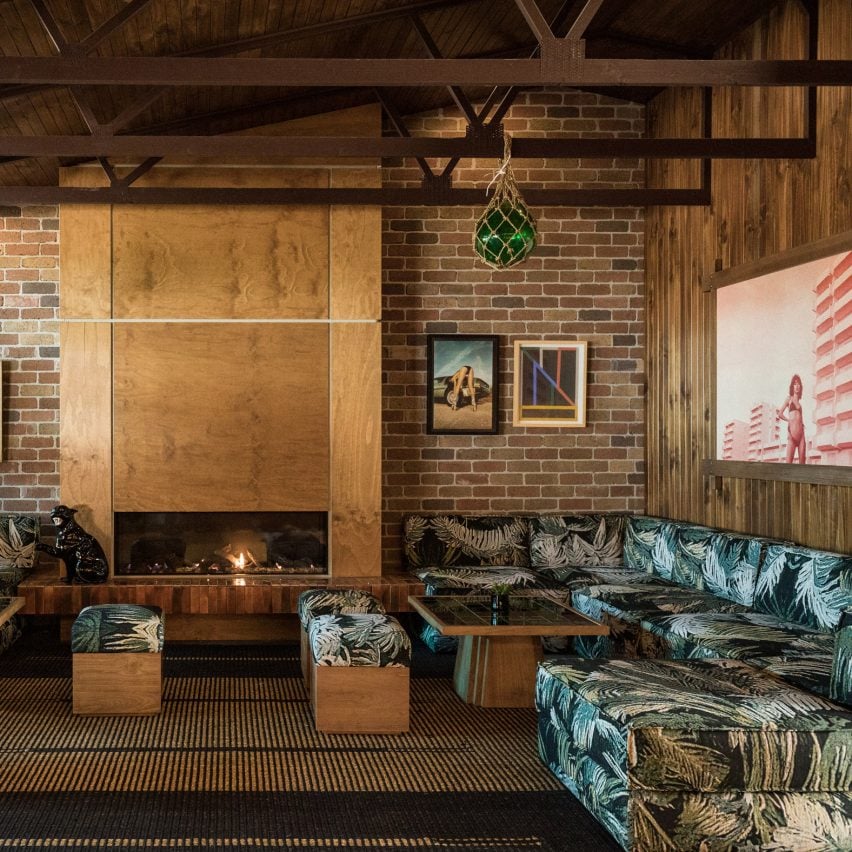Gorrow Design Studio has completed a boutique hotel in the coastal town of Crescent Head, Australia, balancing “1970s surf nostalgia” with bespoke furniture and contemporary craftsmanship.
Gorrow Design Studio founder George Gorrow and his wife Cisco Tschurtschenthaler have revamped the 1980s roadside motel and conference centre into Sea Sea Hotel.
The duo intended the hotel to be “a seaside sanctuary and community clubhouse that blends 1970s surf nostalgia with modernity”.

“Sea Sea is a new form of home that reminds you of the past,” Gorrow told Dezeen.
The single-level hotel’s revamped interiors make use of natural materials and textures, which the designers intended to evoke surf shacks, alpine hunting cabins and old Bali hotels.
“The building had some great eccentricities that really helped lead the design,” Gorrow said.

“Things like stained glass windows, oversized timber rafters, multi-pitched roofs, and a series of sprawling single-level buildings – all these quirks gave the place a sense of character we wanted to celebrate, not erase,” he added.
Previously a conference centre, the common spaces of the hotel – or clubhouse as it’s now called – house the reception, a shop, art gallery, surf hire, listening bar, cocktail lounge and a restaurant that opens out onto a dining terrace directly on the street.

Bedrooms feature exposed brown brick walls, timber rafters, dark-stained pine wood panelling and natural pigment-dyed concrete floors.
Bespoke wall lights, hand-carved by sculptor Aleph Geddis, glow with red light-therapy bulbs – part of an enhanced sleep program developed for guests.

The hotel’s bed throws were designed in collaboration with Korean artist Romon K Yang and feature large-scale hand-screened calligraphic prints on heavyweight cotton linen.
The bedside tables are retro-style speakers, which were custom-built with furniture brand Torre and crafted from stained plywood veneer and Bose hardware.

Bespoke furniture, like floor-level sofas made from huge cushions, was designed to feel “grounded and barefoot”.
“I wanted the floor sofa to feel more like a piece you’d find in a beach house than a hotel – the idea was comfort without any formality,” explained Gorrow.
Crazy paving pathways of silver travertine, lit by slim bollards, wind through the 6,000 square-metre site, across which 25 rooms are scattered in runs of little terraces.
A turquoise-tiled swimming pool features an overspill area edged in pebbles and surrounded by cacti.

Bespoke sun loungers, where the fabric has been strung from a tubular frame with thick rope, are a reinterpretation of 1970s daybeds.
In the listening bar, Gorrow’s own vintage Klipsch La Scala speakers were built into a bespoke vinyl record display unit and a large fireplace with a plywood surround is flanked by bespoke corner sofas.
Throughout the project, Gorrow aimed to preserve as much of the original fabric of the existing buildings as possible.
“We kept as much of the original structures as we could, reusing materials across the project,” he said.
“We recycled old bricks to build privacy screens, shifted pathways to recreate flow, and planted over 3,000 plants to soften lines of sight, frame views and carve out moments of intimacy without losing the open, communal vibe.”

Despite the transformation of the original site and structures, it was important to the designers that the hotel was “rooted in place”.
“It needed to feel like it had always been there, like it belonged,” said Gorrow. “The challenge was to balance nostalgia with freshness – to create something that felt right without trying too hard.”
“There’s a temptation to lean into tropes with coastal or retro spaces, but we were more interested in restraint than cliches.”
“We focused on texture over trends,” Gorrow added. “Rather than chasing a particular ‘look’, the approach was about creating an atmosphere – something sensory and honest.”

Gorrow wanted to use “materials that feel real in the hand, lighting that shifts throughout the day, surfaces that invite touch”.
“It was important that the space felt designed to be used – not styled for a shoot,” he said. “Nothing is overly precious. It had to feel lived-in, approachable, and tactile, inviting, not intimidating.”

Gorrow previously designed the tropical-brutalist resort The Slow in Canggu, Bali, and is also the co-founder of Australian denim brand Ksubi.
Other boutique hotels recently featured on Dezeen include Andrea Rosso’s update of the Pelican Hotel in Miami Beach and a Swiss chalet revamped with mid-century modern furniture by Nicemakers.
The photography is by Tommaso Riva.
The post Australian roadside motel reimagined as ode to 1970s surf culture appeared first on Dezeen.

